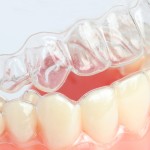
The use of clear overlay orthodontic appliances was first noted in the 1940’s . In the 1990’s it was adapted, incorporating modern technologies to introduce the clear aligner treatment (CAT). The use of CATs is increasing, particularly in adults.
The aim of this review was to assess if CAT is effective in controlling orthodontic movement in non-growing subjects.
Methods
Searches were conducted in the PubMed/Medline, Embase, Cochrane Central Register of Controlled Clinical trials (CENTRAL) Web of Knowledge, Scopus, Google Scholar and LILACS databases. Prospective and retrospective studies of orthodontic treatment with clear aligners in patients with a minimum age of 15 were considered. Two reviewers independently selected studies and quality was assessed using the A grading system described by the Swedish Council on Technology Assessment in Health Care (SBU)
Results
- 11 studies involving a total of 484 patients were included (2 randomised controlled trials , 5 prospective studies and 4 retrospective studies).
- 6 studies were considered to be of moderate quality the remainder of limited quality.
- The amount of mean intrusion reported was 0.72 mm.
- Extrusion was the most difficult movement to control (30% of accuracy), followed by rotation.
- Upper molar distalization revealed the highest predictability (88%) when a bodily movement of at least 1.5 mm was prescribed.
- A decrease of the Little’s Index (mandibular arch: 5 mm; maxillary arch: 4 mm) was observed in aligning arches.
Conclusions
The authors concluded
CAT aligns and levels the arches; it is effective in controlling anterior intrusion but not anterior extrusion; it is effective in controlling posterior buccolingual inclination but not anterior buccolingual inclination; it is effective in controlling upper molar bodily movements of about 1.5 mm; and it is not effective in controlling rotation of rounded teeth in particular. However, the results of this review should be interpreted with caution because of the number, quality, and heterogeneity of the studies.
Commentary
Despite searching a wide range of databases there were only few small studies that met the inclusion criteria for this review and the authors highlight a number of methodological issues. Including inadequate sequence generation (four studies), lack of allocation concealment (three studies), and lack of a proper blinding procedure (four studies). Consequently they indicated that the quality of the evidence was not sufficient to draw any evidence-based decisions on the effectiveness of orthodontic aligners and recommended that high quality randomised controlled trials should be conducted in order to develop protocols for the use of CAT in clinical practice.
Links
Rossini G, Parrini S, Castroflorio T, Deregibus A, Debernardi CL. Efficacy of clear aligners in controlling orthodontic tooth movement: A systematic review. Angle Orthod. 2014 Nov 20. [Epub ahead of print] PubMed PMID: 2541226

Don’t miss – Orthodontic aligners: little evidence of their effectiveness http://t.co/DNi9uu3jN4
[…] Dental Elf – 24th Nov 2014- Orthodontic aligners: little evidence to assess their effectiveness […]
[…] Orthodontic aligners: little evidence to assess their effectiveness […]